WFC News
Yu-ai Friendship
Newsletter of the World Friendship Center, NPO
Korea PAX
Minao Capper
On my trip to Korea though PAX I wanted to find out what the Korean youth feel about peace, understand more about the historical problems between Japan and Korea, and experience the Korean culture. I especially think I now understand the issue about the Korean women forced to be sex slaves by the Japanese military, and I could see it from a different perspective than before.
On the first day, we joined a protest in front of the Japanese embassy. I was surprised that there were many young people, even though it was a national holiday. They were very different from the Japanese students who just sit there quietly because they were told to, but instead they were actively chanting and singing songs. The young people taking it upon themselves to act on what they think is really impressive and inspired me a lot.
On the second day we went to the house of sharing and learned about the horrific things that the Japanese military made these women do in wartime.
When we heard from the Harumonis it made me think that the terrible things that we saw in the museum had happened to these women sitting in front of me.
That thought made me tear up. Going to a Japanese school and studying the Japanese peace education all my life, learning about the truth for the Koreans hurt my heart. All the Harumonis want is a formal apology and for the stories of the so called “comfort women” in the school textbooks. I can’t understand why the Japanese government can’t do that. I said this at the Q and A after Matsumoto san’s story on the third day but, I think if we don’t learn about our past mistakes, we will not be able to achieve a truly peaceful future.
During the Q and A on our third night, I got to see many different perspectives while translating, and when I was asked about what the Japanese youth think or what kind of peace education I had, I did my best to answer those questions but I felt I wasn’t answering the questions as well as I could. Not many people are as privileged as I am to be able to take part in such trips so at the very least, I want to tell my opinions and my experience in Korea to my friends and teachers in Japan.
On our final day we went shopping with my host family, Coco and Austin.
When we got back to the peace building we had diner all together then got in a circle to talk about our memories during our stay. I am so thankful for my amazing host family and all the people who made this possible. I will never forget this experience.
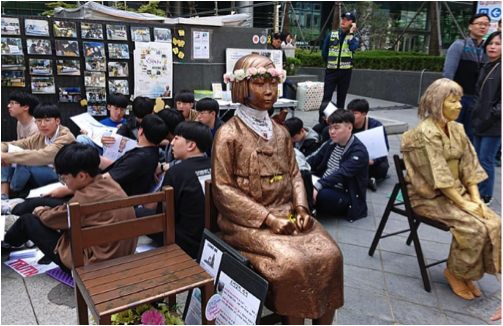
Copyright © NPO World Friendship Center 2019 All Rights Reserved
Yu-ai Friendship
Newsletter of the World Friendship Center, NPO
2019 Korean PAX report
Shizuo Tachibana
I visited South Korea from April 30 to May 5, 2019 as group leader of the Korean PAX tour, the Peace Ambassador Exchange. I would like to share a few thoughts regarding this Korean PAX.
We visited the House of Sharing for victims of Japanese military sexual slavery on May 2. There we met one of the grandmothers, 이옥선 Ii Ukseon, and I apologized to her as a Japanese person. However, she said that she wanted an apology from the Japanese government, not from me. She said that she didn’t expect an apology from the Prime Minister, Shinzo Abe. Hearing that for her my apology meant nothing, I was shocked. At the political level between two countries, there are so many issues going on that need to be resolved. The grandmothers have seven demands, the Japanese staff of the House of Sharing, Mr. Tsukasa Yajima told us. The Japanese government has to answer to these seven demands, which the present government chooses to ignore. Is there anything left, then, that we Japanese citizens can do for these victims of sex slavery?
On May 2, after Ms. Masue Matsumoto shared her experience of the A-bombing, there was a question to her. ‘Why don’t the Japanese ask for an apology from the U.S.?’ She explained about a characteristic attitude of Japanese people to experiences in the past. The Japanese tend to forget what happened, as one releases incidents in the stream of memory. It is not only her, but many hibakusha don’t especially want an apology from the U.S. Instead they say that they don’t want anyone to experience what they did. I know that the Japanese have to apologize and seek to be forgiven because of the war. The Korean grandmothers need an apology from the Japanese government. However, I hope that as Japanese people continue to visit the victims of the sex slavery with their apologies and a heart of love, these may heal them and they will someday accept our apologies. I believe that this is one of the things that Japanese citizen could do about the past.
In the end, I would like to express my sincere thanks to the Peace Building Community for their warm welcome and commitment to this program dedicated to peace between our countries. I hope that Korean PAX will continue to contribute to the peace of this region.
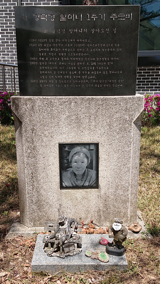
Copyright © NPO World Friendship Center 2019 All Rights Reserved
Yu-ai Friendship
Newsletter of the World Friendship Center, NPO
Joining the study tour to
Kyoto Museum for World Peace, Ritsumeikan University
Katsumi Takahashi
On a light rainy day at the end of January, we traveled to Kyoto to visit the Kyoto Museum for World Peace, Ritsumeikan University. There were eight of us in all: four WFC board members, four Hiroshima Pass-on-Project lecture participants. At Kyoto station, we were met by Ms. Yoshiko Tanigawa, a volunteer guide from the museum. She led us to a bus on which we headed for Ritsumeikan University at the foot of Mt. Kinugasa. According to her explanation, of its type as a university-established museum, it is unsurpassed in the world as regards its scale and exhibits. We were excited, looking forward to seeing all this.
At first we visited Suekawa Memorial hall, named after the honorary president Hiroshi Suekawa who was from Iwakuni. Mr. Suekawa’s relics exhibition was held there. There Ms. Rumi Hanagaki greeted us. She was exposed to the atomic bomb in Yokogawa at the age of five years old. Now she is a caretaker for the Kyoto atomic and hydrogen bomb survivors’ consultation group. After lunch at the restaurant in the hall and introducing ourselves, we heard Ms. Hanagaki’s testimony as a hibakusha. She said that the circumstances at the time of exposure to the blast, especially what she experienced while evacuating to Mitaki had returned to her years later as flashbacks.
Moving to the museum next door, the roses of Anne welcomed us at the entrance. Entering the building, there was a comfortable spacious lounge. On the east and west walls, two “Phoenix fire birds” reliefs by Osamu Tezuka representing the epidemic of past war to bright future were glowing lustrously, and we were met by the impressive enshrined Muchan Peace Statue. Ms. Tanigawa explained that Muchan was a girl with tuberculosis who had been kept quarantined alone in a shelter, and had starved to death without knowing that the war was over.
Then finally we went to the lower first floor to the main permanent display, “Staring at Peace”. The exhibition starts when you go down the stairs looking at the large Wadatsumi (God of the sea) statue along one side. The exhibits on this floor were divided into two themes: the “Fifteen years war” and “Modern wars”. For the “Fifteen years war”, there was a huge display of primary materials with easy to understand neutral explanations based on historical facts. I was deeply impressed. I was able to learn a lot of things which I hadn’t known.
This museum was established following deep reflection on the fact that Ritsumeikan had been a strongly militaristic school before the war. Everywhere I saw the strong intention to nurture the subject of creating peace.
Contents of the respective exhibitions were significant. The themes were: ① Military and soldiers (Characteristics of the imperial army), ② General public mobilization (War cooperation system), ③ Colonies and occupied territories (Anti-Japanese movement), ④ Air raids, the Battle of Okinawa, the Atomic bomb, ⑤ Efforts for peace (about the Japanese antiwar movement), and ⑥ Responsibility for war. Among the exhibits that remain strongly impressed in my memory are the heavy backpacks, up to 30kg, which the soldiers carried, an aerial photograph showing the plan to drop the atomic bomb on Kyoto, which had been among the first possible targets (a circle with a radius of 2.4 km from the Ume alley engine depot), and anti-Japanese slogans.
Then we went upstairs and looked around the “Peace Creation Exhibition Room”. Here, one area for reflecting on violence and peace was introduced, around the central theme of “Peace is not just the absence of conflict”. I became aware of the various issues that exist around us.
In the next room was an exhibition of works from art students who died in the war, kept in this Kyoto Hall section of the “Silent Hall” museum located in Ueda City, Nagano Prefecture. I faced the works of the art students who had lost their lives so young.
In this visit to the Kyoto Museum for World Peace, Ritsumeikan University, through the huge display of exhibits built on academic knowledge, I was able to gain some understanding of the stupidity of war and a realization that peace can be achieved through the proactive behavior of individuals. It was a very meaningful tour for our future peace activities.
Finally, I wish to express my appreciation to our guides, Ms. Tanigawa and Ms. Hanagaki, and to every member of the board of the World Friendship Center.
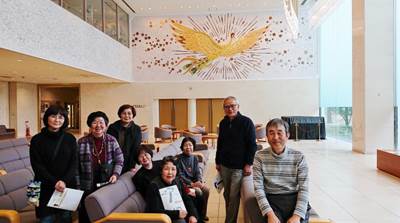
From left to right: Ms. Niki, Ms. Watanabe, Ms. Matsuno,
Ms. Miho, Ms. Kurumaji, Ms. Taguchi,
Mr. Takahashi, Mr. Tachibana
Translated Sumiko Kanetsuna
Copyright © NPO World Friendship Center 2019 All Rights Reserved
Yu-ai Friendship
Newsletter of the World Friendship Center, NPO
In retrospect of the PAX Tour USA
Foundations of Peace
The 12 day PAX Tour was, for me, an experience of many “beginnings.”
My daily experiences and realizations led to seeing Hiroshima through an outside perspective and to think of “peace” in broader ways. It also became a trip of self-discovery.
The sculpture placed at the University of Chicago where the world’s first nuclear reactor was, and the exhibit at the United States Air Force Museum both seemed to showcase the American narrative praising the achievement and development of nuclear power to this day. A statement from a Chinese man at Illinois Wesleyan pointed out the atrocities done by the Japanese imperial army to the Asian countries during WWII. Each with its own story and historical memory, how could we communicate with our eyes collectively toward the future and take steps toward peace? How should our generation pass on the history of Hiroshima?
At the Peace Conference at Illinois Wesleyan, I learned about the present state of those who need “peace” in the world due to conflicts, hate that goes back in history, income disparity, racial and sexual discrimination, etc., and of the works people are doing to better these situations. So what is “peace”? Is peace different for each individual? What are the commonalities?
These are all questions I don’t yet have clear answers for, but ones I was compelled to ask and bring home. I wish to seek answers for these questions as I gain knowledge and hopefully wisdom.
There were two things in particular I’ve noticed through our activities.
First was the several class visits we did at universities. There, we mainly spent time with questions and answers rather than a one-sided presentation. I noticed an active participation along with direct connections with the students that were very meaningful.
Second was the power of art. In my presentation I gave a brief introduction on the project, the “Grandchildren of Hiroshima.” Then there was Amano-san’s one-man drama, “Living with Father.” I realized again that art is one effective avenue that possesses an unique strength in telling the story of Hiroshima. Neither race nor nationality mattered when it came to the power that moves people and naturally leads their heart to empathize as human beings.
Above are the two points I’d like to learn from and utilize in the future. Our presentations were aimed toward university students and older this time, but I’d really like to reach a wider generation of people next time, and hopefully through many avenues including culture, history, testimonies, and art. I hope this would lead each one of us to consider nuclear issues as a humanitarian problem which we face today.
Each day was like opening up a new present. In two occasions I experienced a surprising yet a delightful reunion when a woman came up to me and told me she had known me as a baby. What I’ve realized through meeting many people and having many people take care of us is the importance of communicating, understanding, and connecting; to make a friend. I strongly felt there lies the foundation for peace.
Dan from the Brethren Volunteer Service and his wife, Wendy: Thank you for your overwhelming generosity. Through our nightly conversations, you gave me many new perspectives. Bagels, bacon, to the best coffee. You made my little American dream come true. We couldn’t have asked for a better way to begin our trip.
Josie from Illinois Wesleyan: Thank you for organizing the wonderful Peace Conference that led to so many irreplaceable connections and learning. I sensed a deep gratitude and importance of growing through learning. I loved talking with you about issues surrounding us as human beings and as women.
Tanya from Wilmington: Thank you for giving us the opportunity to experience and to ponder peace from various perspectives. I admire your quiet strength that continues to burn inside your gentleness. And thank you for all the food that were probably-the-best-ever-I’ve-had in-the-states.
Thank you also to the Snyders for helping me see the need to consider the present issues through our past history. Special thanks to the delicious homemade desserts and the extra bacon.
Alice from Bluffton: Reuniting with you after I don’t know how many years and spending your 89th birthday with you was amazing beyond words. Thank you for pouring love on me unchangingly since I was little and even now. Unsurprisingly, surrounding you was a community built on love and it felt as though I caught a glimpse of what peace needs to be founded on.
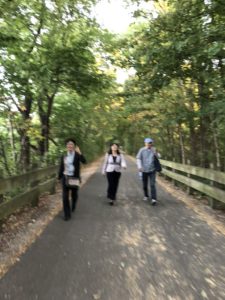
To my fellow PAX members: Thank you for every moment spent supporting each other with our quirky personalities and for all the laughter.
Lastly, I’d like to send my deepest thank you to the people at WFC who have always watched over me and for making me a part of this incredible opportunity.
Picture: I’m sorry the picture is out of focus. These are my 3 fun travel companions taking a walk and singing rather loudly into the woods!
Copyright © NPO World Friendship Center 2018 All Rights Reserved
Yu-ai Friendship
Newsletter of the World Friendship Center, NPO
Thinking back on the 2018 PAX Tour To America:
Peace from a True Spirit of Volunteerism
Miho Nishii
I joined PAX Tour to America from September 17th to September 28th as one of 4 PAX members. We visited 4 places: Elgin and Bloomington – Normal in Illinois; Wilmington and Bluffton in Ohio, to make presentations about peace.
The experiences of having met a lot of people with volunteer spirits in America changed my understanding of volunteerism . I learned that family units in America are open to society and people naturally work for the community as volunteers. It seemed that volunteering work are not hard obligations but delightful opportunities for each of volunteers to help people with needs. They seemingly valued individuality.
I was invited to make my presentations, including short self-introductions, at least 12 times in all during the tour. Although I was not sure if I could make my presentations understood because of my clumsy English, I was very impressed that the people I met in America tried to sincerely listen to and understand my presentations about peace. Thinking back on my presentations, each opportunity was so precious to me, even if I was not satisfied with my poor English.
As the length of this paper is limited, I am not able to introduce every presentation and what happened in this tour, but here I would like to write about the very impressive one, the panel at Illinois Wesleyan University on September 22nd.. It was so impressive because during that 2-hour panel I had been so nervous, had felt uneasy and had been very moved by the presentations of the other panelists. I was aware that the other panelists could speak near-native English and had been very experienced with peace issues. On the other hand, I believed that the heart of my idea about peace (the title was “the Spirit of the Memorial Cenotaph for Atomic Bomb Victims” ) was connected to theirs and those of each of the persons working for world peace.
About 30 minutes before the panel was finished , one Chinese man from the audience had very strong comment on my presentation, blaming the Japanese people for atrocities in China during WWⅡ. I apologized him for the Japan’s atrocities and explained the idea of my presentation, quoting the words of the former Hiroshima Mayer Shinzo Hamai: “There is no winner and no loser in a war. The cenotaph exists for mourning the dead and taking an oath not to bring about wars”.
I don’t know if my response was persuasive to him and I also hope my response was understood by the audience. I remember the moment when I was relieved to hear the clapping of hands from the audience.
I appreciate all the people who were involved in organizing this PAX tour and those who hosted us PAX members for giving us this precious opportunity.
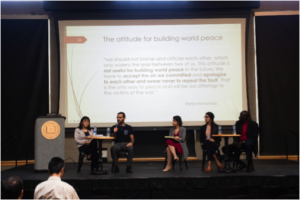
Copyright © NPO World Friendship Center 2018 All Rights Reserved